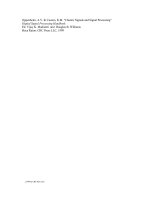Tài liệu Digital Signal Processing Handbook P13 pdf
Bạn đang xem bản rút gọn của tài liệu. Xem và tải ngay bản đầy đủ của tài liệu tại đây (247.57 KB, 15 trang )
Hero, A. “Signal Detection and Classification”
Digital Signal Processing Handbook
Ed. Vijay K. Madisetti and Douglas B. Williams
Boca Raton: CRC Press LLC, 1999
c
1999byCRCPressLLC
13
Signal Detection and Classification
Alfred Hero
University of Michigan
13.1 Introduction
13.2 Signal Detection
TheROCCurve
•
DetectorDesignStrategies
•
LikelihoodRatio
Test
13.3 Signal Classification
13.4 The Linear Multivariate Gaussian Model
13.5 Temporal Signals in Gaussian Noise
Signal Detection: Known Gains
•
Signal Detection: Unknown
Gains
•
Signal Detection: Random Gains
•
Signal Detection:
Single Signal
13.6 Spatio-Temporal Signals
Detection: Known Gains and Known Spatial Covariance
•
Detection: Unknown Gains andUnknown SpatialCovariance
13.7 Signal Classification
Classifying Individual Signals
•
Classifying Presence of Multi-
ple Signals
References
13.1 Introduction
Detection and classification arise in signal processing problems whenever a decision is to be made
among a finite number of hypotheses concerning an observed waveform. Signal detection algo-
rithms decide whether the waveform consists of “noise alone” or “signal masked by noise.” Signal
classification algorithms decide whether a detected signal belongs to one or another of prespecified
classes of signals. The objective of signal detection and classification theory is to specify systematic
strategies for designing algorithms which minimize the average number of decision errors. This
theory is grounded in the mathematical discipline of statistical decision theory where detection and
classification are respectively called binary and M-ary hypothesis testing [1, 2]. However, signal pro-
cessing engineers must also contend with the exceedingly large size of signal processing datasets,
the absence of reliable and tractible signal models, the associated requirement of fast algorithms,
and the requirement for real-time imbedding of unsupervised algorithms into specialized software
or hardware. While ad hoc statistical detection algorithms were implemented by engineers before
1950, the systematic development of signal detection theory was first undertaken by radar and radio
engineers in the early 1950s [3, 4].
This chapter provides a brief and limited overview of some of the theory and practice of signal
detection and classification. The focus will be on the Gaussian observation model. For more details
and examples see the cited references.
c
1999 by CRC Press LLC
13.2 Signal Detection
Assume that for some physical measurement a sensor produces an output waveform x ={x(t) : t ∈
[0,T]} over a time interval [0,T]. Assume that the waveform may have been produced by ambient
noise alone or by an impinging signal of known form plus the noise. These two possibilities are called
the null hypothesis H and the alternative hypothesis K, respectively, and are commonly written in the
compact notation:
H : x = noise alone
K : x = signal + noise.
The hypotheses H and K are called simple hypotheses when the statistical distributions of x under H
and K involve no unknown parameters such as signal amplitude, signal phase, or noise power. When
the statistical distribution of x under a hypothesis depends on unknown (nuisance) parameters the
hypothesis is called a composite hypothesis.
To decide between the null and alternative hypotheses one might apply a high threshold to the
sensor output x and make a decision that the signal is present if and only if the threshold is exceeded
at some time within [0,T]. The engineer is then faced with the practical question of where to set the
threshold so as to ensure that the number of decision errors is small. There are two types of error
possible: the error of missing the signal (decide H under K (signal is present)) and the error of false
alarm (decide K under H (no signal is present)). There is always a compromise between choosing
a high threshold to make the average number of false alarms small versus choosing a low threshold
to make the average number of misses small. To quantify this compromise it becomes necessary to
specify the statistical distribution of x under each of the hypotheses H and K.
13.2.1 The ROC Curve
Let the aforementioned threshold be denoted γ . Define the K decision region R
K
={x : x(t) >
γ, for some t ∈[0,T]}. This region is also called the critical region and simply specifies the con-
ditions on x for which the detector declares the signal to be present. Since the detector makes
mutually exclusive binary decisions, the critical region completely specifies the operation of the de-
tector. The probabilities of false alarm and miss are functions of γ given by P
FA
= P(R
K
|H)and
P
M
= 1−P(R
K
|K)where P(A|H)and P(A|K)denote the probabilitiesofarbitraryevent A under
hypothesis H and hypothesis K, respectively. The probability of correct detection P
D
= P(R
K
|K)
is commonly called the power of the detector and P
FA
is called the level of the detector.
The plot of the pair P
FA
= P
FA
(γ ) and P
D
= P
D
(γ ) over the range of thresholds −∞ <γ <∞
produces a curve called the receiver operating characteristic (ROC) which completely describes the
error rate of the detector as a function of γ (Fig. 13.1). Good detectors have ROC curves which
have desirable properties such as concavity (negative curvature), monotone increase in P
D
as P
FA
increases, high slope of P
D
at the point (P
FA
,P
D
) = (0, 0),etc.[5]. For the energy detection
example shown in Fig. 13.1 it is evident that an increase in the rate of correct detections P
D
can
be bought only at the expense of increasing the rate of false alarms P
FA
. Simply stated, the job of
the signal processing engineer is to find ways to test between K and H which push the ROC curve
towards the upper left corner of Fig. 13.1 where P
D
is high for low P
FA
: this is the regime of P
D
and
P
FA
where reliable signal detection can occur.
13.2.2 Detector Design Strategies
When the signal waveform and the noise statistics are fully known, the hypotheses are simple, and
an optimal detector exists which has a ROC curve that upper bounds the ROC of any other detector,
c
1999 by CRC Press LLC
FIGURE 13.1: The receiver operating characteristic (ROC) curve describes the tradeoff between
maximizing the power P
D
and minimizing the probability of false alarm P
FA
of a test between two
hypotheses H and K. Shown is the ROC curve of the LRT (energy detector) which tests between
H : x = complex Gaussian random variable with variance σ
2
= 1,vs. K : x = complex Gaussian
random variable with variance σ
2
= 5 (7dB variance ratio).
i.e., it has the highest possible power P
D
foranyfixedlevelP
FA
. This optimal detector is called
the most powerful (MP) test and is specified by the ubiquitous likelihood ratio test described below.
In the more common case where the signal and/or noise are described by unknown parameters, at
least one hypothesis is composite, and a detector has different ROC curves for different values of the
parameters (see Fig. 13.2). Unfortunately, there seldom exists a uniformly most powerful detector
whose ROC curves remain upper bounds for the entire range of unknown parameters. Therefore, for
composite hypotheses other design strategies must generally be adopted to ensure reliable detection
performance. There are a wide range of different strategies available including Bayesian detection [5]
and hypothesis testing [6], min-max hypothesis testing [2], CFAR detection [7], unbiased hypothesis
testing [1], invariant hypothesis testing [8, 9], sequential detection [10], simultaneous detection and
estimation [11], and nonparametric detection [12]. Detailed discussion of these strategies is outside
the scope of this chapter. However, all of these strategies have a common link: their application
produces one form or another of the likelihood ratio test.
13.2.3 Likelihood Ratio Test
Here we introduce an unknown parameter θ to simplify the upcoming discussion on composite
hypothesis testing. Define the probability density of the measurement x as f(x|θ) where θ belongs
to a parameter space . It is assumed that f(x|θ)is a known function of x and θ. We can now state
the detection problem as the problem of testing between
H : x ∼ f(x|θ), θ ∈
H
(13.1)
K : x ∼ f(x|θ), θ ∈
K
,
(13.2)
where
H
and
K
are nonempty sets which partition the parameter space into two regions. Note
it is essential that
H
and
K
be disjoint (
H
∩
K
=∅) so as to remove any ambiguity on the
decisions, and exhaustive (
H
∪
K
= ) to ensure that all states of nature in are accounted for.
c
1999 by CRC Press LLC
FIGURE 13.2: Eight members of the family of ROC curves for the LRT (energy detector) which tests
between H : x = complex Gaussian random variable with variance σ
2
= 1, vs. composite K : x =
complex Gaussian random variable with variance σ
2
> 1. ROC curves shown are indexed over a
range [0dB, 21dB] of variance ratios in equal 3dB increments. ROC curves approach a step function
as variance ratio increases.
Let a detector be specified by a critical region R
K
. Then for any pair of parameters θ
H
∈
H
and
θ
K
∈
K
the level and power of the detector can be computed by integrating the probability density
f(x|θ)over R
K
P
FA
=
x∈
R
K
f(x|θ
H
)dx,
(13.3)
and
P
D
=
x∈
R
K
f(x|θ
K
)dx.
(13.4)
The hypotheses (13.1) and (13.2) are simple when ={θ
H
,θ
K
} consists of only two values
and
H
={θ
H
} and
K
={θ
K
} are point sets. For simple hypotheses the Neyman-Pearson
Lemma [1] states that there exists a most powerful test which maximizes P
D
subject to the constraint
that P
FA
≤ α,whereα is a prespecified maximum level of false alarm. This test takes the form of a
threshold test known as the likelihood ratio test (LRT)
L(x)
def
=
f(x|θ
K
)
f(x|θ
H
)
K
>
<
H
η,
(13.5)
where η is a threshold which is determined by the constraint P
FA
= α
∞
η
g(l|θ
H
)dl = α.
(13.6)
Here g(l|θ
H
) is the probability density function of the likelihood ratio statistic L(x) when θ = θ
H
.It
mustalso bementioned thatifthedensity g(l|θ
H
)containsdeltafunctionsasimple randomization [1]
of the LRT may be required to meet the false alarm constraint (13.6).
The test statistic L(x) is a measure of the strength of the evidence provided by x that the probability
density f(x|θ
K
) produced x as opposed to the probability density f(x|θ
H
). Similarly, the threshold
c
1999 by CRC Press LLC
η represents the detector designer’s prior level of “reasonable doubt” about the sufficiency of the
evidence—onlyabovealevelη is the evidence sufficient for rejecting H.
When θ takes on more than twovalues at least one of the hypotheses (13.1)or(13.2) are composite,
and the Neyman Pearson lemma no longer applies. A popular but ad hoc alternative which enjoys
some asymptotic optimality properties is to implement the generalized likelihood ratio test (GLRT):
L
g
(x)
def
=
max
θ
K
∈
K
f(x|θ
K
)
max
θ
H
∈
H
f(x|θ
H
)
K
>
<
H
η
(13.7)
where, if feasible, the threshold η is set to attain a specified level of P
FA
. The GLRT can be interpreted
as a LRT which is based on the most likely values of the unknown parameters θ
H
and θ
K
, i.e., the
values which maximize the likelihood functions f(x|θ
H
) and f(x|θ
K
), respectively.
13.3 Signal Classification
When, based on a noisy observed waveform x, one must decide among a number of possible signal
waveforms s
1
,...,s
p
, p>1,wehaveap-ary signal classification problem. Denoting f(x|θ
i
) the
density function of x when signal s
i
is present, the classification problem can be stated as the problem
of testing between the p hypotheses
H
1
: x ∼ f(x|θ
1
), θ
1
∈
1
.
.
.
.
.
.
.
.
.
H
p
: x ∼ f(x|θ
p
), θ
p
∈
p
where
i
is a space of unknowns which parameterize the signal s
i
. As before, it is essential that the
hypotheses be disjoint, which is necessary for {f(x|θ
i
)}
p
i=1
tobe distinct functions of x for all θ
i
∈
i
,
i = 1,...,p, and that they be exhaustive, which ensures that the true density of x is included in
one of the hypotheses. Similarly to the case of detection, a classifier is specified by a partition of the
space of observations x into p disjoint decision regions R
H
1
,...,R
H
p
. Only p − 1 of these decision
regions are needed to specify the operation of the classifier. The performance of a signal classifier is
characterized by its set of p misclassification probabilities P
M
1
= 1 − P(x ∈ R
H
1
|H
1
),...,P
M
p
=
P(x ∈ R
H
p
|H
p
). Unlike the case of detection (p = 2), even for simple hypotheses, where
i
={θ
i
}
consists of a single point, i = 1,...,p, optimal p-ary classifiers that uniformly minimize all P
M
i
’s
do not exist. However, classifiers can be designed to minimize other weaker criteria such as average
misclassification probability
1
p
p
i=1
P
M
i
[5], worst case misclassification probability max
i
P
M
i
[2],
Bayes posterior misclassification probability [12], and others.
The maximum likelihood (ML) classifier is a popular classification technique which is closely
related to maximum likelihood parameter estimation. This classifier is specified by the rule
decide H
j
if and only if max
θ
j
∈
j
f(x|θ
j
) ≥ max
k
max
θ
k
∈
k
f(x|θ
k
), j = 1,...,p.
(13.8)
When the hypotheses H
1
,...,H
p
are simple, the ML classifier takes the simpler form:
decide H
j
if and only if f
j
(x) ≥ max
k
f
k
(x), j = 1,...,p
where f
k
= f(x|θ
k
) denotes the known density function of x under H
k
. For this simple case it can
be shown that the ML classifier is an optimal decision rule which minimizes the total misclassifica-
tion error probability, as measured by the average
1
p
p
i=1
P
M
i
. In some cases a weighted average
1
p
p
i=1
β
i
P
M
i
is a more appropriate measure of total misclassification error, e.g., when β
i
is the
c
1999 by CRC Press LLC









